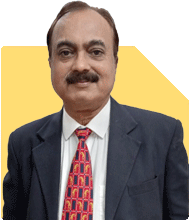What's the Difference Between B.TECH CSE and B.TECH (AI+DS)?
Nayagam P P |10230 Answers |Ask -Follow
Career Counsellor - Answered on Aug 22, 2024
He started his career as an HR professional and has over 10 years of experience in tutoring and mentoring students from Classes 8 to 12, helping them choose the right stream, course and college/university.
He also counsels students on how to prepare for entrance exams for getting admission into reputed universities /colleges for their graduate/postgraduate courses.
He has guided both fresh graduates and experienced professionals on how to write a resume, how to prepare for job interviews and how to negotiate their salary when joining a new job.
Nayagam has published an eBook, Professional Resume Writing Without Googling.
He has a postgraduate degree in human resources from Bhartiya Vidya Bhavan, Delhi, a postgraduate diploma in labour law from Madras University, a postgraduate diploma in school counselling from Symbiosis, Pune, and a certification in child psychology from Counsel India.
He has also completed his master’s degree in career counselling from ICCC-Mindler and Counsel, India.
... more

Sir, what to choose among B.TECH CSE or B.TECH (AI+DS), in DY PATIL PUNE?.. Is DY Patil College good?
To know more on ‘ Careers | Education | Jobs’, ask / Follow Us here in RediffGURUS.
You may like to see similar questions and answers below
Mayank Chandel |2522 Answers |Ask -Follow
IIT-JEE, NEET-UG, SAT, CLAT, CA, CS Exam Expert - Answered on Jun 22, 2024
Dr Dipankar Dutta |1787 Answers |Ask -Follow
Tech Careers and Skill Development Expert - Answered on Aug 10, 2024
Radheshyam Zanwar |6312 Answers |Ask -Follow
MHT-CET, IIT-JEE, NEET-UG Expert - Answered on Aug 05, 2024
Pradeep Pramanik |260 Answers |Ask -Follow
Career And Placement Consultant - Answered on Aug 13, 2024
Nayagam P P |10230 Answers |Ask -Follow
Career Counsellor - Answered on Aug 13, 2025
Nayagam P P |10230 Answers |Ask -Follow
Career Counsellor - Answered on Aug 13, 2025
Dr Nagarajan J S K |2267 Answers |Ask -Follow
NEET, Medical, Pharmacy Careers - Answered on Aug 13, 2025
Radheshyam Zanwar |6312 Answers |Ask -Follow
MHT-CET, IIT-JEE, NEET-UG Expert - Answered on Aug 13, 2025
Radheshyam Zanwar |6312 Answers |Ask -Follow
MHT-CET, IIT-JEE, NEET-UG Expert - Answered on Aug 13, 2025
Radheshyam Zanwar |6312 Answers |Ask -Follow
MHT-CET, IIT-JEE, NEET-UG Expert - Answered on Aug 13, 2025
Radheshyam Zanwar |6312 Answers |Ask -Follow
MHT-CET, IIT-JEE, NEET-UG Expert - Answered on Aug 13, 2025
Nayagam P P |10230 Answers |Ask -Follow
Career Counsellor - Answered on Aug 13, 2025
Nayagam P P |10230 Answers |Ask -Follow
Career Counsellor - Answered on Aug 13, 2025
Nayagam P P |10230 Answers |Ask -Follow
Career Counsellor - Answered on Aug 13, 2025



















